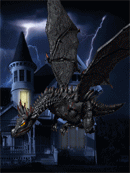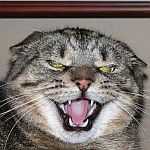[font=Comic Sans MS]Някой знае ли значвнието на хипарския символ?
Чувала съм,че се нарича Вещерска стъпка,но
никъде не мога да открия по-подробно инфо...[/font]
Един символ...
Модератор: EliKarim
Вие нямате нужните права за да сваляте прикачени файлове.
-

dana666 - Мнения: 9
- Регистриран на: 09 Апр 2006, 14:24
- Местоположение: София
Само това намерих, ама е на английски. Иначе аз го знам само като символ на мира.
This forked symbol was adopted as its badge by the Campaign for Nuclear Disarmament in Britain, and originally, its use was confined to supporters of that organization. It was later generalised to become an icon of the 1960s anti-war movement, and was also adopted by the counterculture of the time. It was designed and completed February 21 1958 by Gerald Holtom, a commercial designer and artist in Britain. He had been commissioned by the CND to design a symbol for use at an Easter march to Canterbury Cathedral in against the Atomic Weapons Research Establishment at Aldermaston in England.
against the Atomic Weapons Research Establishment at Aldermaston in England.
The symbol itself is a combination of the semaphoric signals for the letters "N" and "D," standing for Nuclear Disarmament. In semaphore the letter "N" is formed by a person holding two flags in an upside-down "V," and the letter "D" is formed by holding one flag pointed straight up and the other pointed straight down. These two signals imposed over each other form the shape of the peace symbol. In the original design the lines widened at the edge of the circle.
Semaphore 'N'
Enlarge
Semaphore 'N'
Semaphore 'D'
Enlarge
Semaphore 'D'
A conscientious objector who had worked on a farm in Norfolk during the Second World War, Holtom later wrote to Hugh Brock, editor of Peace News, explaining the genesis of his idea in greater depth: "I was in despair. Deep despair. I drew myself: the representative of an individual in despair, with hands palm outstretched outwards and downwards in the manner of Goya’s peasant before the firing squad. I formalised the drawing into a line and put a circle round it." He also mentioned that he had intended its obvious resemblance to the anarchy symbol.
A Peace symbol remains after it has been emblazoned in grass beside Lake Burley Griffin in Canberra, the national capital of Australia.
Enlarge
A Peace symbol remains after it has been emblazoned in grass beside Lake Burley Griffin in Canberra, the national capital of Australia.
The peace symbol flag first became known in the United States in 1958 when Albert Bigelow, a pacifist er, sailed his small boat outfitted with the CND banner into the vicinity of a nuclear test. The peace symbol button was imported into the United States in 1960 by Philip Altbach, a freshman at the University of Chicago, who traveled to England to meet with British peace groups as a delegate from the Student Peace Union (SPU). Altbach purchased a bag of the "chickentrack" buttons while he was in England, and brought them back to Chicago, where he convinced SPU to reprint the button and adopt it as its symbol. Over the next four years, SPU reproduced and sold thousands of the buttons on college campuses.
er, sailed his small boat outfitted with the CND banner into the vicinity of a nuclear test. The peace symbol button was imported into the United States in 1960 by Philip Altbach, a freshman at the University of Chicago, who traveled to England to meet with British peace groups as a delegate from the Student Peace Union (SPU). Altbach purchased a bag of the "chickentrack" buttons while he was in England, and brought them back to Chicago, where he convinced SPU to reprint the button and adopt it as its symbol. Over the next four years, SPU reproduced and sold thousands of the buttons on college campuses.
answers.com
This forked symbol was adopted as its badge by the Campaign for Nuclear Disarmament in Britain, and originally, its use was confined to supporters of that organization. It was later generalised to become an icon of the 1960s anti-war movement, and was also adopted by the counterculture of the time. It was designed and completed February 21 1958 by Gerald Holtom, a commercial designer and artist in Britain. He had been commissioned by the CND to design a symbol for use at an Easter march to Canterbury Cathedral in
 against the Atomic Weapons Research Establishment at Aldermaston in England.
against the Atomic Weapons Research Establishment at Aldermaston in England.The symbol itself is a combination of the semaphoric signals for the letters "N" and "D," standing for Nuclear Disarmament. In semaphore the letter "N" is formed by a person holding two flags in an upside-down "V," and the letter "D" is formed by holding one flag pointed straight up and the other pointed straight down. These two signals imposed over each other form the shape of the peace symbol. In the original design the lines widened at the edge of the circle.
Semaphore 'N'
Enlarge
Semaphore 'N'
Semaphore 'D'
Enlarge
Semaphore 'D'
A conscientious objector who had worked on a farm in Norfolk during the Second World War, Holtom later wrote to Hugh Brock, editor of Peace News, explaining the genesis of his idea in greater depth: "I was in despair. Deep despair. I drew myself: the representative of an individual in despair, with hands palm outstretched outwards and downwards in the manner of Goya’s peasant before the firing squad. I formalised the drawing into a line and put a circle round it." He also mentioned that he had intended its obvious resemblance to the anarchy symbol.
A Peace symbol remains after it has been emblazoned in grass beside Lake Burley Griffin in Canberra, the national capital of Australia.
Enlarge
A Peace symbol remains after it has been emblazoned in grass beside Lake Burley Griffin in Canberra, the national capital of Australia.
The peace symbol flag first became known in the United States in 1958 when Albert Bigelow, a pacifist
 er, sailed his small boat outfitted with the CND banner into the vicinity of a nuclear test. The peace symbol button was imported into the United States in 1960 by Philip Altbach, a freshman at the University of Chicago, who traveled to England to meet with British peace groups as a delegate from the Student Peace Union (SPU). Altbach purchased a bag of the "chickentrack" buttons while he was in England, and brought them back to Chicago, where he convinced SPU to reprint the button and adopt it as its symbol. Over the next four years, SPU reproduced and sold thousands of the buttons on college campuses.
er, sailed his small boat outfitted with the CND banner into the vicinity of a nuclear test. The peace symbol button was imported into the United States in 1960 by Philip Altbach, a freshman at the University of Chicago, who traveled to England to meet with British peace groups as a delegate from the Student Peace Union (SPU). Altbach purchased a bag of the "chickentrack" buttons while he was in England, and brought them back to Chicago, where he convinced SPU to reprint the button and adopt it as its symbol. Over the next four years, SPU reproduced and sold thousands of the buttons on college campuses.answers.com
-

weballergy - MagicGateBg Приятел
- Мнения: 115
- Регистриран на: 18 Юли 2006, 15:16
- Местоположение: almost everywhere
-

dana666 - Мнения: 9
- Регистриран на: 09 Апр 2006, 14:24
- Местоположение: София
това е знака на мирът - хора от всякъде - обединявайте се и се обичайте . Нещо такова значеше . . .
100 Каба Гайди
-

B-L-O-T - MagicGateBg Фен
- Мнения: 1257
- Регистриран на: 13 Май 2006, 06:45
-

B-L-O-T - MagicGateBg Фен
- Мнения: 1257
- Регистриран на: 13 Май 2006, 06:45
http://www.voininatangra.org/modules/news/.На този сайт има информация,само трябва да се потърси.
-

АлексТТ - Мнения: 7
- Регистриран на: 17 Мар 2007, 22:56
Алгиз обаче обърнат.
В вампириката този рун се използва с цел отслабване на противника защита и жизнена сила.
може би затова хипитата са толкова пропаднали и жалки
В вампириката този рун се използва с цел отслабване на противника защита и жизнена сила.
може би затова хипитата са толкова пропаднали и жалки
Agnoscetis Dei, scio ipse
-

Abathor - MagicGateBg Приятел
- Мнения: 185
- Регистриран на: 02 Яну 2007, 18:42
-

АлексТТ - Мнения: 7
- Регистриран на: 17 Мар 2007, 22:56
АлексТТ написа:Обърнат на обратно,това е знак ТАНГРА.
хахахаха.... нищо лично, но няма как да не се изсмея на подобно изказване- вземи се поинтересувай малко повече за символите на божествата, преди да даваш подобни "компетентни" мнения...

-

Nemezius - Модератор
- Мнения: 941
- Регистриран на: 18 Юни 2006, 20:32
- Местоположение: Templi Ad Noctum
-

АлексТТ - Мнения: 7
- Регистриран на: 17 Мар 2007, 22:56
Може ли аз да пробвам ? Едно време белия гълъб е бил символ на мира че дори и сега си е така (примерно гърция ако не ме лъже памета там кадето е захапал маслинова клонка нещо от сорта имаше).Символа идва от крака на пилето и пак означава мир.Е обаче сега се замислих защо е обърнат сигорно върви назаде просто :D трябва да проуча но това за белия гълъб и какво символизираа този кръг еи добре че сте вие да да почна да мисля и аз бе  като разбера (ако разбера ! ) ще кажа
като разбера (ако разбера ! ) ще кажа
-

BeFree - Мнения: 8
- Регистриран на: 20 Юни 2007, 19:49
-

morsko_zaklinanie - MagicGateBg Наблюдател
- Мнения: 39
- Регистриран на: 18 Юни 2008, 09:56
да но обърнат този знак е руната EOLH-буквално значеща "защита"-закрила от злото.Това е знак на вдигнатата косо пред тялото,с длан напред ръка.Щит против нападение.Знак за мир.Магически е бариера против нападение или нещастие.Предпазва индивида от нараняване от друг човек.
H8 ME
-

sin angel - MagicGateBg Приятел
- Мнения: 310
- Регистриран на: 21 Яну 2008, 13:15
- Местоположение: в мечтите ти
-

sin angel - MagicGateBg Приятел
- Мнения: 310
- Регистриран на: 21 Яну 2008, 13:15
- Местоположение: в мечтите ти
15 мнения
• Страница 1 от 1